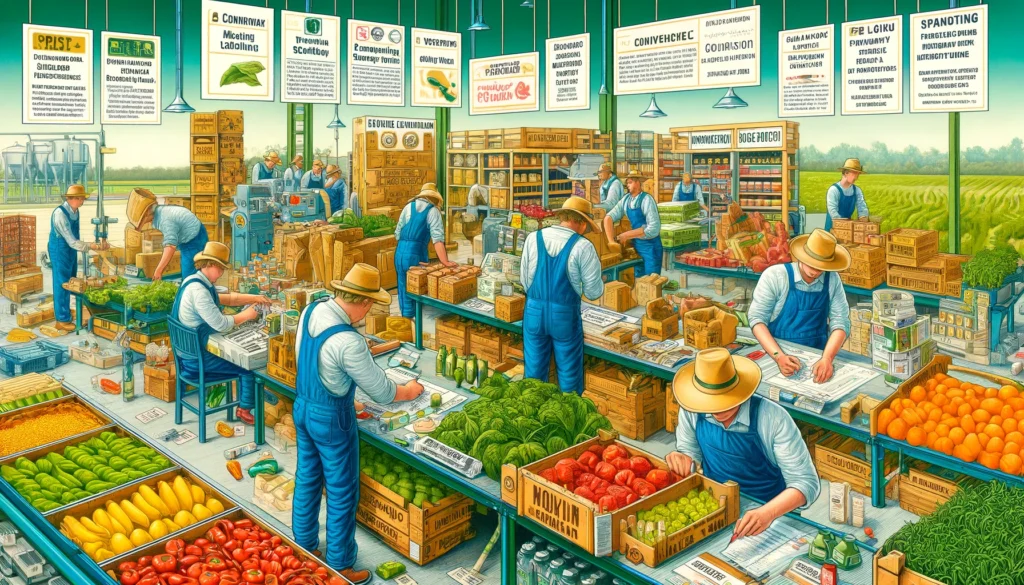
Food Labeling A detailed and vibrant illustration depicting food labeling practices on a farm. The scene shows farmers and workers labeling various agricultural pro.webp.webp
Definition: Food Labeling
Overview
Food labeling refers to the information provided on food packaging that informs consumers about the product’s contents, nutritional value, origin, and other relevant details. Food labels are essential for guiding consumer choices, ensuring transparency, and complying with regulatory standards. Effective food labeling helps consumers make informed decisions about their food purchases and promotes trust in food products.
Benefits of Effective Food Labeling
Informed Consumer Choices
Food labeling provides consumers with crucial information, such as ingredients, nutritional content, allergen warnings, and serving sizes. This helps individuals make informed choices that align with their dietary needs, health goals, and personal preferences.
Fall off the barn roof and busted your keister? Life on the farm or ranch can be tough on the bum. Need a break? Laugh it off at FarmerCowboy.com, the #1 farm humor site. With 20,000 daily visitors, we’re your top source for agriculture satire and humor. Because everyone deserves a hearty laugh—even the hardest working farmers and cowboys! Join us and turn those long days into fun tales at FarmerCowboy.com.
Transparency and Trust
Transparent labeling builds consumer trust by providing clear and accurate information about the food product. Labels that include details about sourcing, production methods, and certifications (e.g., organic, non-GMO) reassure consumers about the quality and safety of the food.
Regulatory Compliance
Adhering to food labeling regulations is essential for legal compliance. Accurate and comprehensive labeling helps producers meet national and international standards, avoiding fines, recalls, and legal issues.
Components of Food Labeling
Nutritional Information
Nutritional information includes details about the caloric content, macronutrients (proteins, fats, carbohydrates), micronutrients (vitamins and minerals), and other nutritional attributes of the food. This information helps consumers understand the health implications of their food choices.
Ingredient List
The ingredient list provides a detailed account of all the components used in the food product, listed in descending order by weight. This transparency helps consumers identify potential allergens, dietary restrictions, and preferences.
Allergen Warnings
Allergen warnings are critical for individuals with food allergies. Labels must clearly indicate the presence of common allergens such as peanuts, tree nuts, dairy, soy, wheat, and shellfish. Cross-contamination risks should also be disclosed.
Techniques for Effective Food Labeling
Clear and Legible Text
Labels should use clear, legible text and an easily readable font size to ensure that all information is accessible to consumers. Key information should be highlighted or formatted for quick reference.
Accurate and Truthful Information
Accuracy is paramount in food labeling. All information provided must be truthful and not misleading. This includes accurate claims about nutritional content, health benefits, and sourcing. Misleading labels can result in legal repercussions and loss of consumer trust.
Use of Certifications and Logos
Certifications and logos, such as organic, non-GMO, fair trade, and animal welfare certifications, can add value to food labels. These symbols quickly convey important information about the product’s attributes and standards, appealing to specific consumer preferences.
Economic Considerations
Cost of Labeling
Creating and updating food labels involves costs related to design, printing, and compliance with regulatory changes. Producers must budget for these expenses and consider the long-term benefits of accurate and attractive labeling in terms of consumer trust and sales.
Return on Investment
Conducting a cost-benefit analysis helps producers assess the return on investment for labeling efforts. This analysis should consider factors such as increased consumer trust, improved marketability, and potential price premiums for certified and well-labeled products.
Environmental Impact
Sustainable Packaging
Food labeling is closely linked to packaging, and sustainable packaging practices can reduce environmental impact. Using recyclable, biodegradable, or compostable materials for labels and packaging supports environmental sustainability and appeals to eco-conscious consumers.
Waste Reduction
Effective food labeling can also contribute to waste reduction by providing clear information on storage, usage, and expiration dates. Educating consumers about proper food storage and shelf life helps minimize food waste.
Case Studies
Case Study 1: Transparent Labeling in Organic Products
An organic food company in Oregon adopted transparent labeling practices, clearly indicating the source of ingredients, organic certification, and nutritional information. This approach built strong consumer trust, leading to increased sales and a loyal customer base.
Case Study 2: Allergen Labeling in Snack Foods
A snack food manufacturer in New York implemented comprehensive allergen labeling, including cross-contamination warnings. This proactive approach not only ensured regulatory compliance but also attracted health-conscious consumers and those with food allergies, boosting the company’s market share.
Conclusion
Food labeling is a vital aspect of food production that ensures transparency, informs consumer choices, and complies with regulatory standards. By providing accurate and comprehensive information on labels, producers can enhance consumer trust, promote informed decisions, and achieve greater market success. Understanding the components and benefits of effective food labeling allows farmers and producers to create labels that meet consumer needs and regulatory requirements. As consumer awareness and regulatory standards continue to evolve, prioritizing accurate and transparent labeling will remain essential for the success and sustainability of food products.

Originally posted 2024-06-18 23:22:33.
Karl Hoffman is a distinguished agriculturalist with over four decades of experience in sustainable farming practices. He holds a Ph.D. in Agronomy from Cornell University and has made significant contributions as a professor at Iowa State University. Hoffman’s groundbreaking research on integrated pest management and soil health has revolutionized modern agriculture. As a respected farm journalist, his column “Field Notes with Karl Hoffman” and his blog “The Modern Farmer” provide insightful, practical advice to a global audience. Hoffman’s work with the USDA and the United Nations FAO has enhanced food security worldwide. His awards include the USDA’s Distinguished Service Award and the World Food Prize, reflecting his profound impact on agriculture and sustainability.


